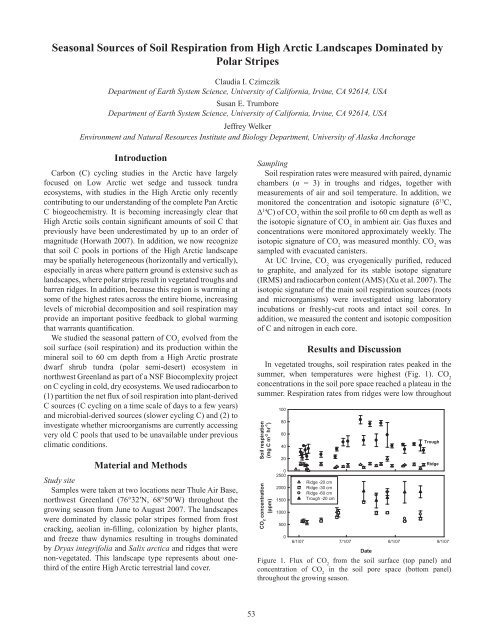Ninth International Conference on Permafrost ... - IARC Research
Ninth International Conference on Permafrost ... - IARC Research
Ninth International Conference on Permafrost ... - IARC Research
You also want an ePaper? Increase the reach of your titles
YUMPU automatically turns print PDFs into web optimized ePapers that Google loves.
Seas<strong>on</strong>al Sources of Soil Respirati<strong>on</strong> from High Arctic Landscapes Dominated byPolar StripesClaudia I. CzimczikDepartment of Earth System Science, University of California, Irvine, CA 92614, USASusan E. TrumboreDepartment of Earth System Science, University of California, Irvine, CA 92614, USAJeffrey WelkerEnvir<strong>on</strong>ment and Natural Resources Institute and Biology Department, University of Alaska AnchorageIntroducti<strong>on</strong>Carb<strong>on</strong> (C) cycling studies in the Arctic have largelyfocused <strong>on</strong> Low Arctic wet sedge and tussock tundraecosystems, with studies in the High Arctic <strong>on</strong>ly recentlyc<strong>on</strong>tributing to our understanding of the complete Pan ArcticC biogeochemistry. It is becoming increasingly clear thatHigh Arctic soils c<strong>on</strong>tain significant amounts of soil C thatpreviously have been underestimated by up to an order ofmagnitude (Horwath 2007). In additi<strong>on</strong>, we now recognizethat soil C pools in porti<strong>on</strong>s of the High Arctic landscapemay be spatially heterogeneous (horiz<strong>on</strong>tally and vertically),especially in areas where pattern ground is extensive such aslandscapes, where polar strips result in vegetated troughs andbarren ridges. In additi<strong>on</strong>, because this regi<strong>on</strong> is warming atsome of the highest rates across the entire biome, increasinglevels of microbial decompositi<strong>on</strong> and soil respirati<strong>on</strong> mayprovide an important positive feedback to global warmingthat warrants quantificati<strong>on</strong>.We studied the seas<strong>on</strong>al pattern of CO 2evolved from thesoil surface (soil respirati<strong>on</strong>) and its producti<strong>on</strong> within themineral soil to 60 cm depth from a High Arctic prostratedwarf shrub tundra (polar semi-desert) ecosystem innorthwest Greenland as part of a NSF Biocomplexity project<strong>on</strong> C cycling in cold, dry ecosystems. We used radiocarb<strong>on</strong> to(1) partiti<strong>on</strong> the net flux of soil respirati<strong>on</strong> into plant-derivedC sources (C cycling <strong>on</strong> a time scale of days to a few years)and microbial-derived sources (slower cycling C) and (2) toinvestigate whether microorganisms are currently accessingvery old C pools that used to be unavailable under previousclimatic c<strong>on</strong>diti<strong>on</strong>s.Material and MethodsStudy siteSamples were taken at two locati<strong>on</strong>s near Thule Air Base,northwest Greenland (76°32′N, 68°50′W) throughout thegrowing seas<strong>on</strong> from June to August 2007. The landscapeswere dominated by classic polar stripes formed from frostcracking, aeolian in-filling, col<strong>on</strong>izati<strong>on</strong> by higher plants,and freeze thaw dynamics resulting in troughs dominatedby Dryas integrifolia and Salix arctica and ridges that weren<strong>on</strong>-vegetated. This landscape type represents about <strong>on</strong>ethirdof the entire High Arctic terrestrial land cover.SamplingSoil respirati<strong>on</strong> rates were measured with paired, dynamicchambers (n = 3) in troughs and ridges, together withmeasurements of air and soil temperature. In additi<strong>on</strong>, wem<strong>on</strong>itored the c<strong>on</strong>centrati<strong>on</strong> and isotopic signature (δ 13 C,Δ 14 C) of CO 2within the soil profile to 60 cm depth as well asthe isotopic signature of CO 2in ambient air. Gas fluxes andc<strong>on</strong>centrati<strong>on</strong>s were m<strong>on</strong>itored approximately weekly. Theisotopic signature of CO 2was measured m<strong>on</strong>thly. CO 2wassampled with evacuated canisters.At UC Irvine, CO 2was cryogenically purified, reducedto graphite, and analyzed for its stable isotope signature(IRMS) and radiocarb<strong>on</strong> c<strong>on</strong>tent (AMS) (Xu et al. 2007). Theisotopic signature of the main soil respirati<strong>on</strong> sources (rootsand microorganisms) were investigated using laboratoryincubati<strong>on</strong>s or freshly-cut roots and intact soil cores. Inadditi<strong>on</strong>, we measured the c<strong>on</strong>tent and isotopic compositi<strong>on</strong>of C and nitrogen in each core.Results and Discussi<strong>on</strong>In vegetated troughs, soil respirati<strong>on</strong> rates peaked in thesummer, when temperatures were highest (Fig. 1). CO 2c<strong>on</strong>centrati<strong>on</strong>s in the soil pore space reached a plateau in thesummer. Respirati<strong>on</strong> rates from ridges were low throughoutSoil respirati<strong>on</strong>(mg C m -2 hr -1 )CO 2c<strong>on</strong>centrati<strong>on</strong>(ppm)10080604020025002000150010005000Ridge -20 cmRidge -30 cmRidge -60 cmTrough -20 cmDateTroughRidge6/1/07 7/1/07 8/1/07 9/1/07Figure 1. Flux of CO 2from the soil surface (top panel) andc<strong>on</strong>centrati<strong>on</strong> of CO 2in the soil pore space (bottom panel)throughout the growing seas<strong>on</strong>.53
















